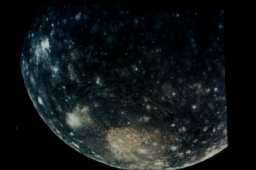This is a close-up image of Europa
Click on image for full size
NASA
Can there be Life in the Environment of Europa?
At first you might think that Europa was unfriendly to
life as we know it on earth.
Like other icy moons, Europa is small, with no air to breathe. On the surface, the temperature is very very cold.
But, inside of Europa there may be liquid water under the surface.
On Earth, we know that there are some creatures which can survive in an environment of very cold water, such as under the ice of the north pole.
This means that, if the conditions are just right, there may be living creatures on Europa under the icy surface!
You might also be interested in:

The Galileo mission discovered an amazing thing! Europa has its own atmosphere, although it is very, very thin. When fast moving molecules traveling through space near Jupiter hit Europa's atmosphere,
...more
The diagram to the left shows the possible interior of Europa. The composition of the icy moons is mostly ice, therefore there is probably a small core of rocky material buried inside, covered with ice.
...more
Amalthea was discovered by E Barnard in 1872. Of the 17 moons it is the 3rd closest to Jupiter. Amalthea is about the size of a county or small state. Amalthea is named after the goat in Greek mythology
...more
Callisto was first discovered by Galileo in 1610. It is the 2nd largest moon in the solar system, and is larger than the Earth's moon. It is about as big as the distance across the United States. Callisto
...more
Measurements by the Galileo spacecraft have been shown that Callisto is the same inside from the center to the surface. This means that Callisto does not have a core at the center. This means that, unlike
...more
Many different types of surface are shown in this picture. In the front is a huge crater, which goes for a long way over the surface. This crater could be compared to that of Mimas. They both show that
...more
The surface of Callisto is deeply marked with craters. Craters are the little white marks in the picture. It looks like it might be the most heavily cratered body in the whole solar system. And some of
...more














